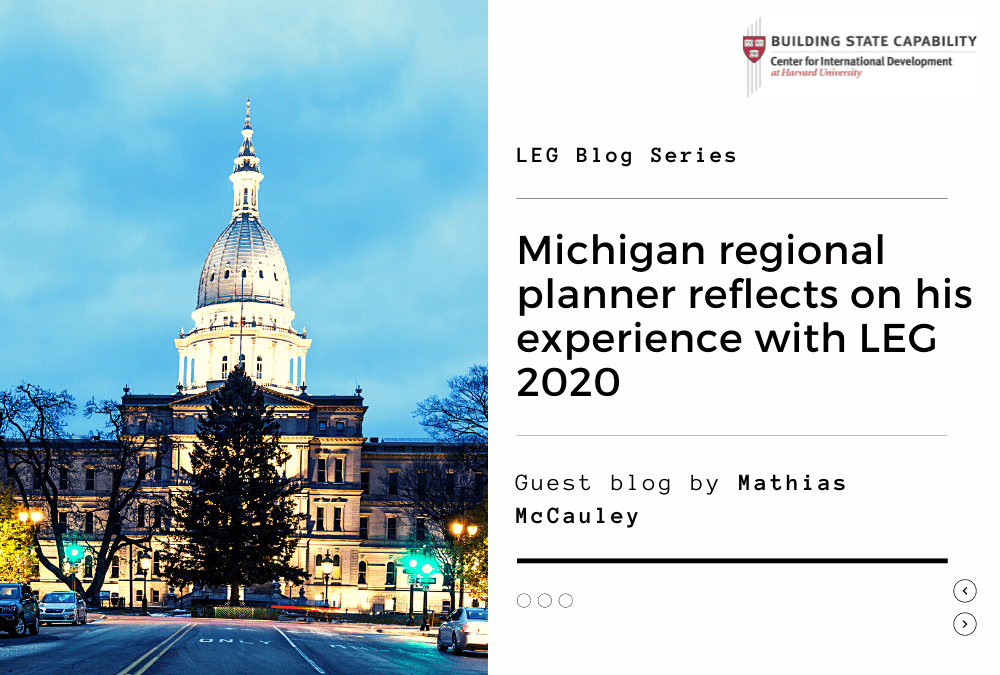Guest blog by Mathias McCauley
What are some key ideas/learnings that you will take away from this course?
The initial lectures on the “product space” and “PDIA” were fascinating and valuable to me. Additionally, because of the nature of my organization and the state the region is located in (Michigan), I now believe that the most likely entry point for positive change is located within “acceptance” and “ability,” not “authority.” Beginning with acceptance, my organization and I must (and will) continue framing the issue as critical to the long-term prosperity and health of the region.
Data shows that rural regions like mine are susceptible to the continued decline of wealth without greater integration of a knowledge-based economy, industry diversification, younger workforce, and higher educational attainment. Policymaker and private industry leadership “acceptance” of this will be dependent on the sharing and belief of such information. Then, “ability” can be achieved by creating “acceptance coalitions” of public and private sector institutions that can affect positive change through organizational strategy and policy.
What progress did you make or what insights did you have about your growth challenge throughout the 10-week time period?
I think the key insights were around resiliency and sustainability. Rural areas, already struggling with population aging and loss, must find innovative ways to expand their workforce and provide for greater earnings or risk a further out-migration of working-age adults to urban areas- affecting local access to good services, taxes for infrastructure, and the local schools. Rural areas that are able to maintain or even grow their working-age populations are more likely to be areas with higher wages and/or lower costs of living.
Moreover, progress moving forward needs to include inclusivity measurements to maximize the labor force’s fullest human capital potential. GDP is important, per capita income is important, but showing gains in GDP and income per capita by specific demographic groups will show progress in optimizing labor and productivity. Delineated economic performance and contribution by demographic group will prove beneficial to measure inclusivity progress and economic growth.
How are you using or will you use what you have learned in this course?
As a leader in my organization and community, I think allowing for a variety of individuals to think critically and identify problem statements is the best path forward, as opposed to presenting or seeking “solutions.” The strengths of this approach include the inclusivity of people and ideas. Additionally, it provides for a Socratic Method, which can stimulate critical thinking and cooperative action. However, it has the potential to be a flawed approach if the “right” people aren’t part of the process- namely homogenous groups, those that don’t have the expertise or those that aren’t comprised of individuals that can move from idea to action.
What open questions do you have that you wish the next course could answer?
The course was very focused on macro-economic principles- which were sound and valuable. However, I would love to see a microeconomic version(s) as a follow-up. Specifically, sessions on rural, small city and metropolitan strategies to lead economic growth would be extremely valuable to practitioners like me.
Economic development practitioners overly focus on decades-old strategies of incenting large employers through tax abatements and alike. The lack of opposing thinking in economic development is stifling communities and creating large chasms in resiliency and sustainability.
Feel free to add photos of your fishbone diagrams, assignments, meetings or whatever you think is relevant (video/audio). This is your opportunity to share your story and be creative – so have fun!!!
This course allowed me to demonstrate a commitment of lifelong learning for me and my family. On Tuesdays, I would tell my boys that I was “going to school,” just like them and, that evening, as a family we each talked about what we learned about at school that day. My sons are 4 and 2, but are seeing the value of education and critical thinking from their parents on a daily basis.

Of note… telling a four year old that the only difference between a zebra and bear is just the letter “z” makes for a pretty funny joke!
This is a blog series written by the alumni of the Leading Economic Growth Executive Education Program at the Harvard Kennedy School. 65 Participants successfully completed this 10-week online course in May 2021. These are their learning journey stories.
To learn more about Leading Economic Growth (LEG) watch the faculty video, and visit the course website.
